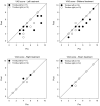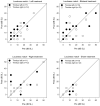Effect of Ipsilateral, Contralateral or Bilateral Repetitive Transcranial Magnetic Stimulation in Patients with Lateralized Tinnitus: A Placebo-Controlled Randomized Study
- PMID: 35741618
- PMCID: PMC9220993
- DOI: 10.3390/brainsci12060733
Effect of Ipsilateral, Contralateral or Bilateral Repetitive Transcranial Magnetic Stimulation in Patients with Lateralized Tinnitus: A Placebo-Controlled Randomized Study
Abstract
The relative benefit of ipsilateral, contralateral, and bilateral repetitive transcranial magnetic stimulation (rTMS) for tinnitus treatment remains unclear, especially for patients with lateralized tinnitus. In this study, we compared outcomes after 10 sessions of 1-Hz rTMS at 110% of resting motor threshold over a two-week period. In total, 104 right-handed patients with lateralized subjective tinnitus were randomly divided into four groups according to rTMS treatment: Left (n = 29), Right (n = 23), Bilateral (n = 30), and Sham stimulation (n = 22). Outcomes included estimates of tinnitus severity, psychological state, and psychoacoustic measures. Patients with left- or right-sided tinnitus were similarly distributed across treatment groups. There were no significant changes in outcome measures for the Right or Sham treatment groups. For the Left and Bilateral groups, tinnitus severity was significantly lower after treatment (p < 0.05). The reduction in tinnitus severity was largest for ipsilateral treatment in the Left group. The overall response rate was 56.1% for the Left group, 46.7% for the Bilateral group, 8.3% for the Right group, and 8.3% for the Sham group. For the Left and Bilateral groups, the response rate was larger for patients with left- than right-sided tinnitus. Changes in tinnitus severity were best predicted by changes in anxiety, depression, and the loudness of the tinnitus. The results suggests that rTMS on the left temporoparietal cortex is more effective for patients with left-sided than with right-sided tinnitus.
Keywords: lateralized tinnitus; repetitive transcranial magnetic stimulation; subjective tinnitus; visual analogue scale.
Conflict of interest statement
The authors declare no conflict of interest.
Figures








References
-
- Cima R.F., Maes I.H., Joore M.A., Scheyen D.J., El Refaie A., Baguley D.M., Anteunis L.J., van Breukelen G.J., Vlaeyen J.W. Specialised treatment based on cognitive behaviour therapy versus usual care for tinnitus: A randomised controlled trial. Lancet. 2012;379:1951–1959. doi: 10.1016/S0140-6736(12)60469-3. - DOI - PubMed
Grants and funding
LinkOut - more resources
Full Text Sources

